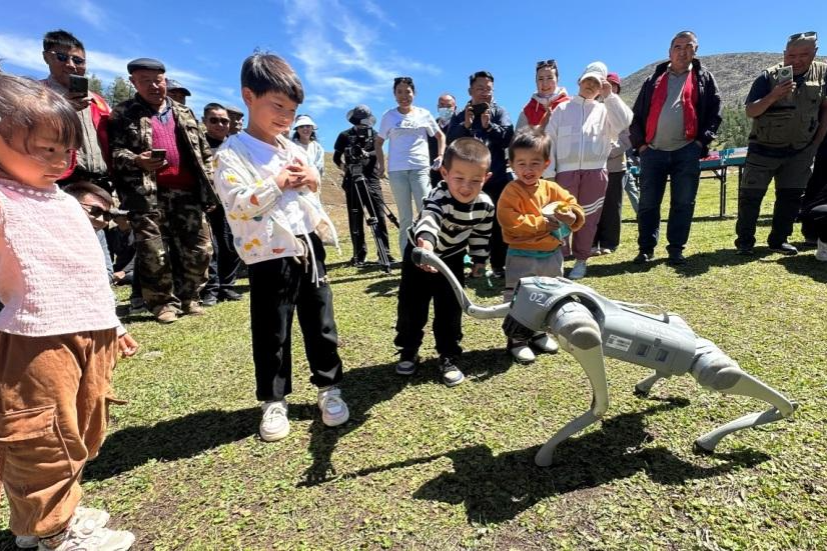Enduring bonds of everlasting friendship

Better ties will help boost economic cooperation between Russia and China
Some people can't help asking why Russian President Vladimir Putin should take part in the Conference on Interaction and Confidence Building Measures in Asia. The answer is that Asia is of special significance to Russia. Representing the combination of European and Asian systems, both geographically and politically, Russia objectively bonds the great expanse of land known as Eurasia.

The Asian part of Russia (West and East Siberia, plus the Far East) accounts for two-thirds of its land area. More than half of Russia's Asian territory is not suited for human habitation because of its severe climate. In winter, temperatures often drop to minus 50-60 C, as a considerable portion of the territory is in the permafrost zone.
The total number of people living between the Urals and Chukotka/Kamchatka Peninsula is a little more than 30 million, or just over 20 percent of Russia's total. For 500 years, Russia's Asian region - primarily, its southern part - has been explored and populated by Russians, Ukrainians, Byelorussians and other nationalities from the European part of the country. It should be noted that the commercial use of agricultural land - a highly risky endeavor - is an achievement of the working people of this region and highlights their contribution to Russia's development. These and other important factors of the Russian economy and security are mutually beneficial to its Asian neighbors.
The Asian part of Russia is rich in precious resources such as oil, gas, coal, timber, diamonds and freshwater. Extraction of these resources is a difficult and expensive proposition. But mastering of natural wealth is the basis of Russia's economic well-being and prosperity.
Another important point is that the only warm-water port that provides Russia direct access to the world's oceans after the collapse of the Soviet Union is in the Far East, while the Northern Sea route offers a unique transportation opportunity to connect Western Europe with East Asia and North America. During the Soviet era, Siberia and the Far East became the regions of efficient development and frantic economic activities. As a result, during World War II, Siberia and the Urals became the workshops that forged the Soviet Union's victory over Nazi Germany and fascist Japan.
After being elected president of Russia for the first time in the early 2000s, Putin started the comprehensive development of Siberia and the Far East to enable the regions to help realize Russia's policy of revival and modernization.
The development of this vast expanse of land meets the development interests of Russia as well its neighbors. Russia considers the rise of Siberia and the Far East as an important factor for mutually beneficial cooperation with its Asian neighbors and partners, especially China.
It is in this context that Russia-China energy cooperation is determined by long-term interests rather than transitory considerations. And the Ukraine crisis has once again emphasized Russia's need to diversify its approach to such cooperation.
The actions of the United States and European Union countries amply demonstrate the defects of Russia's lop-sided dependence on the EU for its energy exports, a practice established by influential business circles in Russia in the 1990s. In the early 2000s, Putin took major initiatives to expand cooperation with China and other Asian countries, which saw the Skovorodino-Daqing oil pipeline being put into operation.
Russia has broad-scale plans to build oil-and-gas pipelines to China, to jointly explore the coal reserves in Southern Yakutia and to realize other major projects. These plans were outlined by Russia and China long before the outbreak of the Ukraine crisis, which highlights the strategic rather than vulgar-bargain approach of the two countries to economic cooperation in different, including energy, fields.
To cap it all, China and Russia on May 21 inked the long-awaited gas deal in Shanghai, ending the decade-long natural gas supply talks between the two neighbors.
Coinciding with Putin's visit to China will be the joint Moscow-Beijing military drills in the East China Sea, over which some countries have raised concerns. But these countries should realize that Russia-China military drills are not targeted against any country. They are aimed at just demonstrating the real potential of the two countries' strategic interaction and partnership in defense and protection of each other's national interests and territorial integrity.
The current nature of Russia-China strategic interaction meets the requirements of the times, is aimed at addressing the problems emerging across the world, and enables the two countries to safeguard their sovereignty and pursue their independent courses.
Russia and China have established bilateral consultation mechanisms at many levels - from regular summits and meetings of heads of government, ministers and agencies' directors through people-to-people exchanges. All this shows the effectiveness, political self-sufficiency and huge potential of Russia-China strategic interaction and partnership. Besides, the military drills in the East China Sea will serve as proof of the trust the two countries have in their cooperation. This factor certainly cannot go unnoticed by other countries, including the US and Japan.
The author is president of Russia-China Friendship Association and director of the Institute of Far Eastern Studies, affiliated to the Russian Academy of Sciences. The views do not necessarily reflect those of China Daily.
(China Daily Africa Weekly 05/23/2014 page13)
Today's Top News
- US interests best served by dialogue not coercion: Editorial flash
- China's move on rare earths aimed at safeguarding the industry
- China's express delivery volume tops 150 billion parcels
- MOFCOM spokesperson's remarks on China's economic and trade policies and measures
- China defends rare earth export controls, urges US to manage differences through dialogue
- UN chief to attend Gaza peace summit in Egypt






























